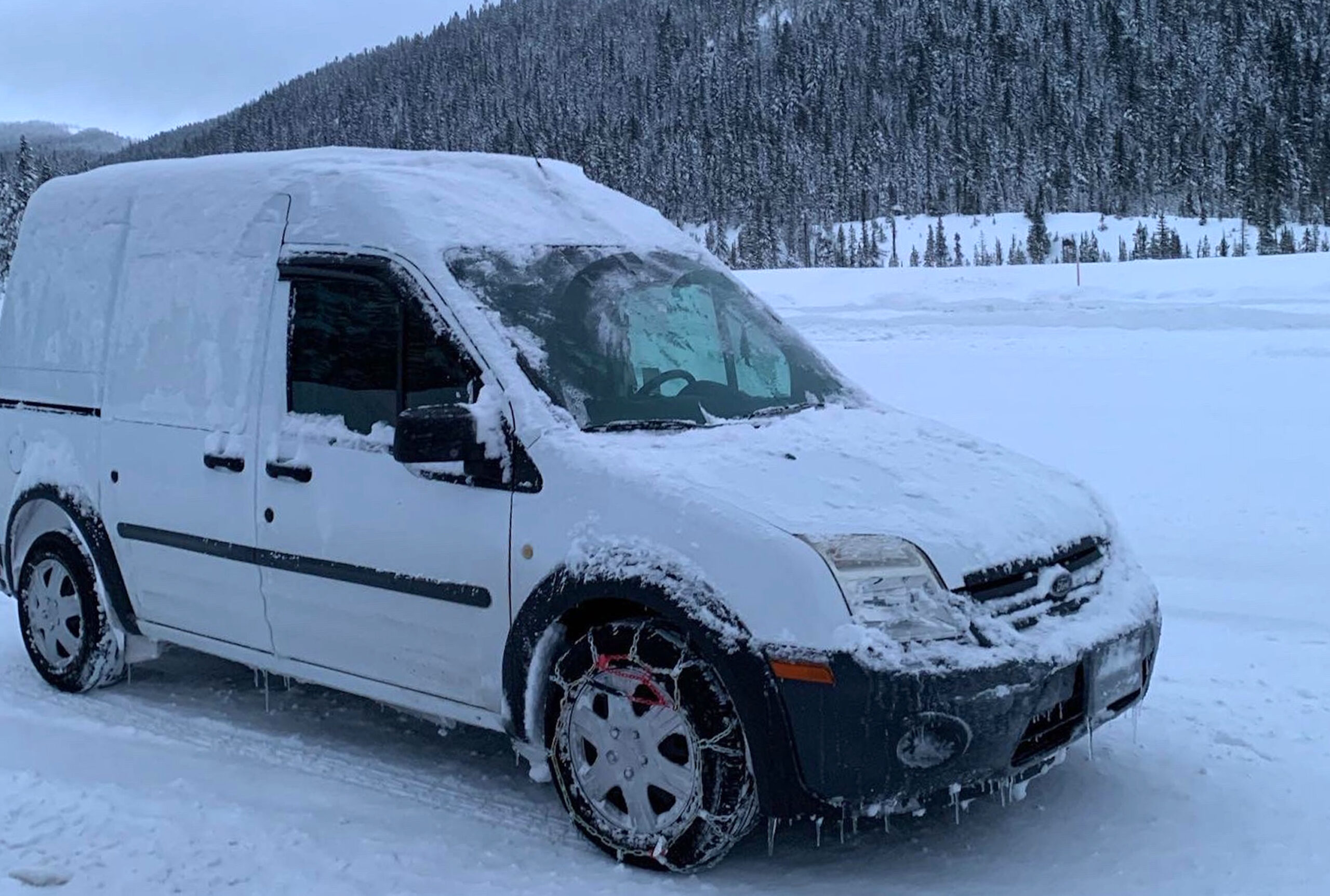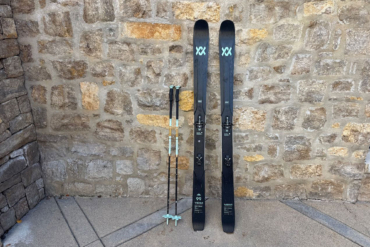Winter is classically inhospitable. If you live in an area that gets freezing temperatures or snow (most of North America), you know how critical preparing your home for winter can be. The same goes for preparing your van; whether you are a full-time or part-time van lifer, there are many ways to enjoy life on the road when the mercury drops.
Camping close to ski resorts or near trailheads is a great way to cut down on traffic or make the most out of your ski day, and even save money. It’s a trick I use all the time.
But in order to do so, you need your van to be warm.
Preparing your van for winter starts with your build-out, but if you didn’t know you’d want to camp in winter when you first began your journey with your van, we have plenty of other solutions to help you stay warm and comfortable (post-build). These tips are geared toward all budgets and sizes of vans.
As you read through, use what you love and don’t mind the rest, or pass them to a friend who has been craving more time in the snow, but isn’t quite sure how to get out there.
Winter Build-Out 101: Analyze Your Needs
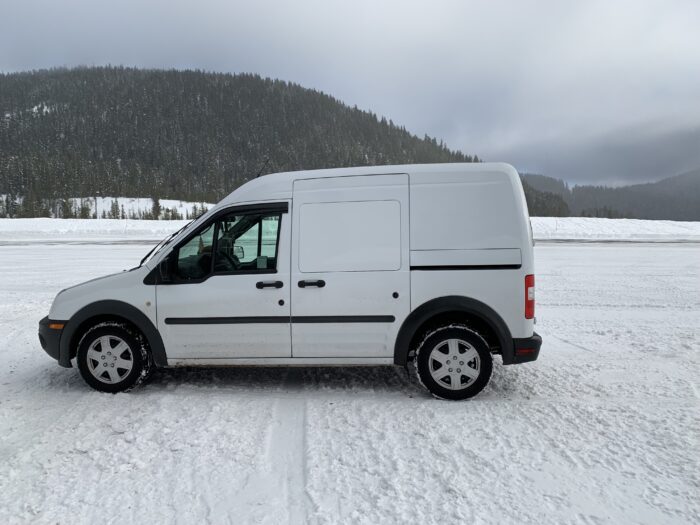
Planning your build is a fun, exhausting, and shockingly time-consuming part of owning a campervan. You can spend endless hours on YouTube researching and do the build yourself, or work with an outfitter if the former idea intimidates you. Van builds range from cheap and reasonable (like mine!) to a luxury mini-home on wheels.
The first step is to be entirely honest about how often you will be in your van, what you will use it for, what you need, and what you can live without. Then, make a budget. Not everyone needs a fancy build, a shower, or even electricity (!).
Truly understanding your wants versus needs — and what you can live without — will help you find what is truly a priority in your build. Talk it through with friends, ask other folks with vans, look at other builds. I’d recommend going lighter on your build because you can come in later and add, change, or take things out. Your build is not as permanent as it seems.
For example, I knew my budget was limited, and my primary focus was a van build that didn’t require extensive work, but would still last for at least a few years until I had a better idea of exactly what I wanted. I knew I would be in my van year-round for up to 7-10 days at a time.
I knew I could do without running water and electricity, which cut down my costs, but I had to make adjustments to ensure that I would be warm, like prioritizing insulation. I own a 2013 Transit Connect with some quirks that I had to consider in my build.
Ways to Stay Warm in a Van
Insulation
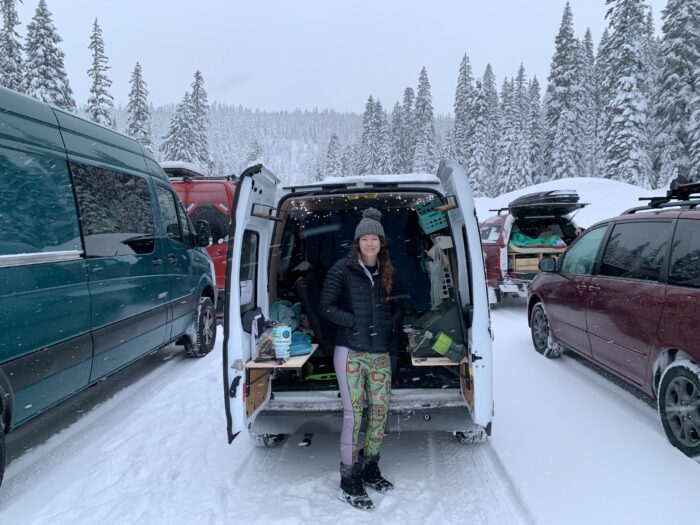
This is likely the number-one way you’ll maintain warmth in a van in the winter season. Choosing the insulation in your van is a vital step in your build process. Sheep’s wool or spray foam are the most popular types of insulation, but other options exist and can work well. Each type of insulation has its pros and cons.
We recommend doing in-depth research before committing to a particular type of insulation. You may also want different insulation for your floor or ceiling than for your walls. Keep in mind some vans also have ribbed or curved walls or ceilings. When pulling apart my van, I learned it had ribbed ceilings and curved walls, which changed my insulation plan.
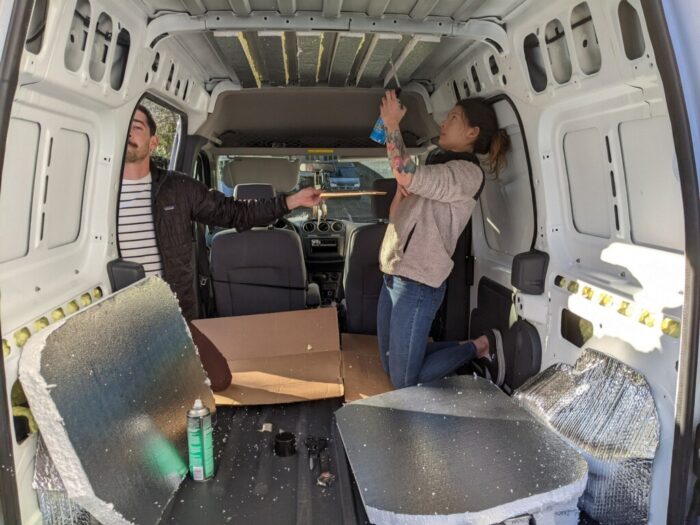
In my build, I used a blend of spray foam and foam board with Reflectix for certain areas. The downsides of foam include that some spray foam can tear through sheet metal while expanding, so it should be applied with caution. It is also messy. I got some stuck in my hair during my build.
Overall, the foam board is easy to cut and install and has excellent R-value (aka insulating properties) for the money spent. If you are doing your build yourself, you will at some point over- or underestimate your materials and need to run to the hardware store, so buying materials that are available locally can be a lifesaver if you’re on a timeline.
Electricity and Heaters
If you opt to install your electricity yourself, or work with an outfitter who will do this for you, you have many heating options available. You can use a heated blanket at night or an electric heater. However, many plug-in electric heaters use a lot of power; we don’t recommend them if you’re using solar panels.
If you have a diesel van, these heaters can be installed and integrated into your van and will pull diesel from your fuel tank. You can leave these running overnight. Butane and propane heaters are also an option.
Mr. Heater Buddy units are a popular choice, as there are many other models out there, but be sure to look for auto-shut-off features and anti-tipping features. Both propane and butane heaters come with carbon monoxide or tipping risks. Please ensure that you have the proper ventilation, such as a fan, in your vehicle.
Additionally, having a carbon monoxide monitor and a smoke alarm in your van is vital.
Portable Generators

One of the easiest ways to add electricity to your van without dealing with wires is by buying a portable generator like a Jackery or GoalZero. There are also several other brands available on the market. These can be powered via solar panels purchased separately, charged by your vehicle, or plugged into a wall socket.
They come in all different sizes, or charging capabilities. Some smaller models are great for charging a phone or laptop, while others can run small kitchen appliances. Models like the Jackery Explorer 1000 can power an electric blanket for up to 14 hours, which could keep you warm all night and leave you with no need for a heater.
Portable generators can also recharge hand warmers and are generally extremely handy to have on hand whether your van has electricity or not.
Other Heating Tools

The value of plenty of warm blankets or a warm sleeping bag can not be overstated. A big, warm, cozy down comforter can be your best friend on a cold night. I like to have a couple of extra blankets on hand for particularly cold or snowy nights, too. I also like to keep down blankets from Rumpl and Nomadix on hand for campfire days, but they work great as extra layers on chilly nights.
Another option for warmth is hot water bottles; you can heat water on a stove and fill these up and slide them in a sleeping bag or under covers for additional warmth.
Handwarmers, whether disposable or rechargeable, can also add a little extra warmth to cold nights, but this is usually marginal as it only serves the extremities.
Considerations for Vans Without Fans
If you opt to go without a fan in your van, like mine, and rely on insulation alone and your van’s existing heating system that you would use while driving or operating the vehicle, then you will need some way to ensure that you don’t overwhelm your small space with carbon monoxide.
A carbon monoxide monitor is a critical tool. If you have excellent insulation, then your van can retain the heat put out by the heater for much of the night, meaning you should stay warm through most, if not all, of the night.
Additionally, another tool for ventilation is rain visors. Rain visors are cheap and quite easy to install, and they allow you to keep your windows partially rolled down at night and keep some airflow in your vehicle.
Because I don’t use an electric blanket or heater, I run my van’s heater before bed, with my windows cracked, and turn off the heater before I go to sleep. I leave the windows cracked while I sleep. The rain visors help reduce moisture entering my vehicle and keep some air circulating.
Final Notes

Whether you choose to use a heater, or go heatless and rely on insulation and other tools, it is possible to stay toasty even in single-digit temperatures.
We hope you can utilize some of these ideas whether you are just beginning to plan your build or are far along in your journey with your campervan. Set forth, play in the snow by day, and then enjoy a toasty night within the four walls of your winterized van.
